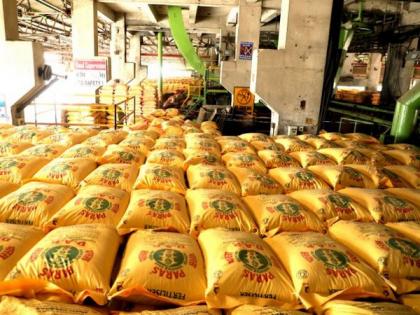Centre firm on not burdening farmers despite impact on supply, production of fertilizers due to Russia-Ukraine war
By ANI | Published: April 28, 2022 07:11 PM2022-04-28T19:11:06+5:302022-04-28T19:20:02+5:30
The central government has decided to provide more funds to meet the rising cost of fertilisers due to higher import prices and not pass the burden to farmers. The subsidy bill of the government on fertilizers is likely to be Rs 2.5 lakh crore this fiscal, a huge increase compared to Rs 1.62 lakh crore last year.

Centre firm on not burdening farmers despite impact on supply, production of fertilizers due to Russia-Ukraine war
The central government has decided to provide more funds to meet the rising cost of fertilisers due to higher import prices and not pass the burden to farmers. The subsidy bill of the government on fertilizers is likely to be Rs 2.5 lakh crore this fiscal, a huge increase compared to Rs 1.62 lakh crore last year.
Government sources toldthat the COVID-19 pandemic led to disturbance in fertiliser production, import and transportation and while its ripple effects were being felt, Russia-Ukraine conflict added to problems in terms of production and supply of fertilizers.
"The prices of fertilizers like DAP, urea and the raw materials like ammonia and .phosphoric acid registered growth up to 250 to 300 per cent," a source in Chemical and Fertilizer Ministry told ANI.
Sources said that the Centre has been proactive in addressing challenges concerning fertiliser price.
"The government strategy has remained two-pronged. On one hand, the government mobilised the importing companies to secure adequate quantities on which there is import dependency, on the other hand, the Indian farmers have been shielded from this price rise by pumping in more subsidy," the source added.
Sources also said that throughout the pandemic, there have been disruptions in the logistics chain which affected the shipping lines globally. They said the average freight rates for ships jumped up to four times and this added to the cost of imported fertilizers.
The sources also said that Europe, the US, Brazil and South-East Asia kept importing fertilizers in huge quantities at higher prices as the agriculture sector, especially corn cultivation, registered an unprecedented jump. This scenario of competing demands posed a unique challenge for India.
They said the demand-supply equation resulted in tight fertilizer availability and continuous price rise.
Ministry sources said that historically this type of challenge in the fertilizer sector was witnessed in 2007-2008 during the global financial crisis. However, the crisis lasted for less than a year and the situation got normalised.
But this time the crisis has prolonged since 2020 because of COVID-19 and Russia-Ukraine war and the Modi government decided to increase subsidies to reduce the burden on farmers, the sources said.
With the reduction in imports from China, India explored alternate sources like Russia, Morocco, Saudi Arabia, Jordan, Israel and Canada. "Indian PSUs like NFL, RCF have entered long-term arrangement for DAP and NPK imports from Russia. Some quantities have been received during the last Rabi season and more quantities are expected during the current Kharif season," the source said.
Sources said that Union Health Minister Mansukh Mandaviya is likely to visit Oman, Morocco, and Saudi Arabia as part of efforts to maintain the supply chain of fertilizers.
The sources said despite global problems of fertilizers production and supply, the government is keen to ensure that farmers do not face a scarcity of fertilizers in the country.
They said Morocco's OCP being the leading exporter for phosphatic fertilizers was approached last year and 15 LMT (DAP, phosphoric acid) were imported.
"India's success lies in the fact that various fertilizers and raw materials were secured with a 20 per cent price advantage as compared to major consuming countries like Brazil, Europe, America. This was made possible through long-term contracts and suitable interventions at government to government level," the source said.
Ministry sources said the Russia-Ukraine crisis disrupted the supplies especially DAP and NPK from Russia. In anticipation of a dip in supplies from OCP Morocco, India is likely to secure supplies of various Phosphatic and Potassic (P&K) fertilizers from Jordan, Israel, Saudi Arabia and Canada.Ministry sources said that when the countries across the globe are struggling to secure fertilizers, India has pre-positioned various fertilizers adequately. The target pre-positioning is always at the level of 25 per cent of the seasonal requirement which stands at 33 per cent for the current Kharif season.
In case of any future adverse situation globally due to geopolitical factors, India will be embarking upon Atma Nirbhar initiative. The option of domestic mining of raw materials like rock phosphate is being explored on the topmost priority for which the inter-ministerial consultation has started.
In the case of urea, the coming up of the plants like Matix, Ramagundam and Gorakhpur have given impetus to self-sufficiency.
The Centre did micromanagement in the movement of fertilizers and the fertilizers were made available to all parts of the country in close coordination with respective state governments.
( With inputs from ANI )
Disclaimer: This post has been auto-published from an agency feed without any modifications to the text and has not been reviewed by an editor
Open in app